形容词和副词的原级
形容词,副词及原级
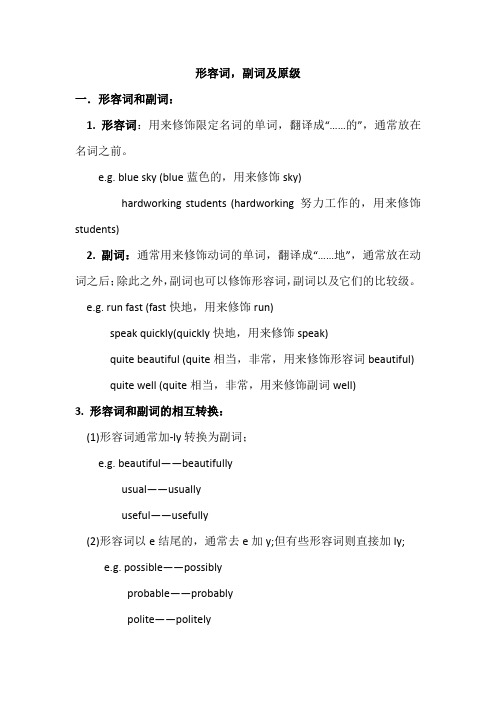
形容词,副词及原级一.形容词和副词:1. 形容词:用来修饰限定名词的单词,翻译成“……的”,通常放在名词之前。
e.g. blue sky (blue蓝色的,用来修饰sky)hardworking students (hardworking努力工作的,用来修饰students)2. 副词:通常用来修饰动词的单词,翻译成“……地”,通常放在动词之后;除此之外,副词也可以修饰形容词,副词以及它们的比较级。
e.g. run fast (fast快地,用来修饰run)speak quickly(quickly快地,用来修饰speak)quite beautiful (quite相当,非常,用来修饰形容词beautiful)quite well (quite相当,非常,用来修饰副词well)3. 形容词和副词的相互转换:(1)形容词通常加-ly转换为副词;e.g. beautiful——beautifullyusual——usuallyuseful——usefully(2)形容词以e结尾的,通常去e加y;但有些形容词则直接加ly;e.g. possible——possiblyprobable——probablypolite——politely(3)但以-ly结尾的单词不一定是副词;e.g. friendly友好的lovely可爱的lonely孤单的deadly致命的(4)有些词既可以作形容词也可以作副词,加了ly之后意思发生改变;或许它本身就是副词。
e.g. hard work辛苦的工作work hard工作努力hardly ever几乎不曾run fast跑得快二.原级1.定义:两者进行比较,后者与前者在某方面相同或不同。
2.形式:(1)肯定形式:…as +形容词或副词的原级+ as…,表示前者和后者一样;(2)否定形式:…not as/so +形容词或副词的原级+ as…,表示前者不如后者。
e.g. He is as friendly as his sister.He is not as/so friendly as his sister.She works as hard as Mary.She doesn’t work as hard as Mary.3.注意:原级针对的词是形容词及副词。
形容词和副词的原级、比较级和最高级

形容词、副词的原级、比较级和最高级规则变化1.一般在词尾直接加er或est,例如,tall-taller-tallest,long-longer-longest2.以不发音的字母e结尾的单词在词尾直接加r或st,例如,nice-nicer-nicest3.以辅音字母+y结尾的词,把y变为i,再加er或est,例如,heavy-heavier-heaviest4.重读闭音节,末尾只有一个辅音字母,双写这个辅音字母,再加er或est,例如,big-bigger-biggest5.部分双音节词和多音节词分别在原级前加more构成比较级和most构成最高级,例如,slowly-more slowly-most slowly;beautiful-more beautiful-most beautiful等级的用法一、原级的用法1.只能修饰原级的词,very,quite,so,too例如,He is too tired to walk on.他太累了以至于不能再继续走了。
My brother runs so fast that I can…t follow him.我弟弟跑得那么快以至于我跟不上他。
2.原级常用的句型结构(1)“甲+be+(倍数)+as+形容词原级+as+乙”表示“甲和乙程度相同”或“甲是乙的几倍”例如,Tom is as old as Kate.汤姆和凯特年龄一样大。
Tom is twice as old as Kate.汤姆的年龄是凯特的二倍。
“甲+实意动词+(倍数)+as+副词原级+as+乙”表示“甲和乙程度相同”或“甲是乙的几倍”例如,Tom runs as fast as Mike.汤姆和迈克跑得一样快。
Tom runs twice as fast as Mike.汤姆跑得速度是迈克的二倍。
(2)“甲+be+not+as/so+形容词原级+as+乙”甲不如乙…例如,This room is not as/so big as that one. 这个房间不如那个大。
形容词和副词原级的常用句型

形容词和副词原级的常用句型形容词和副词原级是英语语法中最基础的部分,它们描述名词和动词的特征和状态。
以下是一些常用的形容词和副词原级句型:1. 主语 + be动词 + 形容词例如:She is beautiful. (她很美丽。
)2. 主语 + 动词 + 形容词例如:He looks tired. (他看起来很疲惫。
)3. 主语 + 副词 + 动词例如:She sings well. (她唱得很好。
)4. 主语 + 动词 + 副词例如:He walks slowly. (他走得很慢。
)5. 主语 + 动词 + 形容词 + than + 名词例如:He is taller than his brother. (他比他的兄弟高。
) 6. 主语 + 动词 + more/less + 形容词 + than + 名词例如:She is more intelligent than her classmates. (她比她的同学更聪明。
)7. 主语 + 动词 + as + 形容词 + as + 名词例如:He is as tall as his father. (他和他的父亲一样高。
) 8. 主语 + 动词 + enough + to + 动词原形例如:She is old enough to drive. (她已经够大了可以开车。
) 9. 主语 + 副词 + enough + to + 动词原形例如:He runs fast enough to catch the bus. (他跑得够快可以赶上公交车。
)10. 主语 + be动词 + too + 形容词 + to + 动词原形例如:The box is too heavy to lift. (这个箱子太重了,搬不动。
)以上是一些常用的形容词和副词原级句型,它们可以帮助你更好地描述你所想表达的意思。
形容词和副词的比较等级详解
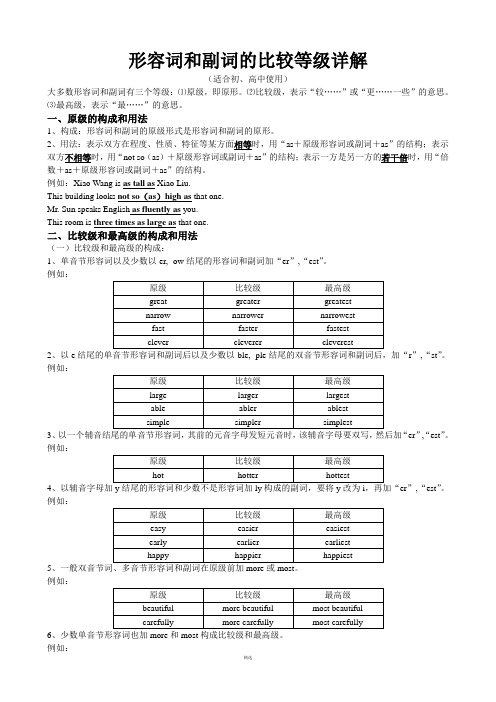
形容词和副词的比较等级详解(适合初、高中使用)大多数形容词和副词有三个等级:⑴原级,即原形。
⑵比较级,表示“较……”或“更……一些”的意思。
⑶最高级,表示“最……”的意思。
一、原级的构成和用法1、构成:形容词和副词的原级形式是形容词和副词的原形。
2、用法:表示双方在程度、性质、特征等某方面相等时,用“as+原级形容词或副词+as”的结构;表示双方不相等时,用“not so(as)+原级形容词或副词+as”的结构;表示一方是另一方的若干倍时,用“倍数+as+原级形容词或副词+as”的结构。
例如:Xiao Wang is as tall as Xiao Liu.This building looks not so(as)high as that one.Mr. Sun speaks English as fluently as you.This room is three times as large as that one.二、比较级和最高级的构成和用法(一)比较级和最高级的构成:1、单音节形容词以及少数以-er, -ow结尾的形容词和副词加“er”,“est”。
例如:2、以e r”,“st”。
例如:3、以一个辅音结尾的单音节形容词,其前的元音字母发短元音时,该辅音字母要双写,然后加“er”,“est”。
例如:4er”,“est”。
例如:5例如:6、少数单音节形容词也加more和most构成比较级和最高级。
781、双方比较,表示一方超过另一方时,用“比较级+than”的结构表示。
例如:This pen is better than that one.2、表示一方不及另一方时,用“less+原级+than”的结构表示。
例如:This room is less beautiful than that one.3、表示一方超过另一方的程度或数量时,可在比较级前加表示程度的状语,如:even, a lot, a bit, a little, still, much, far, yet, by far等修饰。
英语语法 形容词和副词的原级比较

②“not+as/so+形容词/副词原级+as”表示 “……不如……”。
This room is not as/so big as that one.
这个房间不如那个大。
②“not+as/so+形容词/副词原级+as”表示 “……不如……”
我们生产的小汽车和去年ቤተ መጻሕፍቲ ባይዱ样多。
③如果第一个as/so后的形容词和副词作定语修 饰名词,应将该名词及相关修饰语都放在第一 个as/so之后。
I don't make as/so much money as you do.
我挣的钱不如你挣的多。
Mary doesn’t dress so/as strangely as the other girls.
玛丽的穿着没有其他女生奇特。
③如果第一个as/so后的形容词和副词作定语修 饰名词,应将该名词及相关修饰语都放在第一 个as/so之后。
We have produced as many cars as we did last year.
(1)原级的用法
①“as+形容词/副词原级+as”表示双 方在程度、特征等方面相等。
This kind of language appeared as early as the Stone Age. 这种语言最早出现在石器时代。
(1)原级的用法 ①“as+形容词/副词原级+as”表示 双方在程度、特征等方面相等。
early quickly clear
形容词和副词比较等级分为原级、比 较级最高级
形容词和副词原级的常用句型
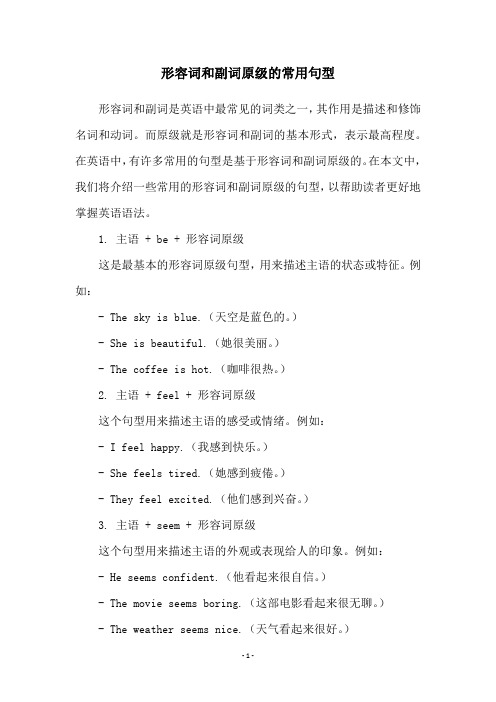
形容词和副词原级的常用句型形容词和副词是英语中最常见的词类之一,其作用是描述和修饰名词和动词。
而原级就是形容词和副词的基本形式,表示最高程度。
在英语中,有许多常用的句型是基于形容词和副词原级的。
在本文中,我们将介绍一些常用的形容词和副词原级的句型,以帮助读者更好地掌握英语语法。
1. 主语 + be + 形容词原级这是最基本的形容词原级句型,用来描述主语的状态或特征。
例如:- The sky is blue.(天空是蓝色的。
)- She is beautiful.(她很美丽。
)- The coffee is hot.(咖啡很热。
)2. 主语 + feel + 形容词原级这个句型用来描述主语的感受或情绪。
例如:- I feel happy.(我感到快乐。
)- She feels tired.(她感到疲倦。
)- They feel excited.(他们感到兴奋。
)3. 主语 + seem + 形容词原级这个句型用来描述主语的外观或表现给人的印象。
例如:- He seems confident.(他看起来很自信。
)- The movie seems boring.(这部电影看起来很无聊。
)- The weather seems nice.(天气看起来很好。
)4. 主语 + become + 形容词原级这个句型用来描述主语的变化或转变。
例如:- The water becomes cold.(水变冷了。
)- She becomes angry.(她生气了。
)- The sky becomes dark.(天空变得暗了。
)5. 主语 + 副词原级 + 动词这个句型用来描述主语的行为或状态。
例如:- He runs fast.(他跑得快。
)- She speaks fluently.(她讲得很流利。
)- They work hard.(他们工作很努力。
)6. 主语 + 动词 + 副词原级这个句型用来描述主语的动作方式或程度。
形容词和副词的原级、比较级和最高级知识点

形容词和副词的原级、比较级和最高级知识点一、定义形容词和副词有三个等级,即原级、比较级和最高级。
比较级主要用于两者之间作比较,最高级主要用于三者或三者以上进行比较。
二、形容词和副词的比较级与最高级的变化规则三、重要句式原级句式(1)as+原级+as...像...一样not as/so+原级+as不如I am as tall as Yao Ming.我和要命一样高。
I am not so tall as Yao Ming.我不如姚明高。
(2)A+谓语动词+倍数+as+原级+as B,表示"A是B的……倍"Our school is twice as large as theirs.我们学校是他们学校的两倍大。
比较级句式(3)a little,a bit,a lot,much,even+比较级,表程度。
Yao Ming is much taller than you.姚明比你高多了。
You are even shorter than me.你甚至比我还矮。
The weather today is a lot warmer than it was yesterday.今天的天气比昨天暖和多了。
(4)比较级+and+比较级,表示"越来越……,”多音节词和部分双音节词用"more and more+原级"It’s becoming colder and colder.天气变得越来越冷了。
The problem is becoming more and more serious.问题变得越来越严重了。
(5)the+比较级,the+比较级,表示"越……就越……"The more you eat,the fatter you will be.吃得越多,就越胖。
(6)比较级常见句式:Which/Who+谓语动词+比较级,A or B?Who runs faster,Jim or Tom?谁跑得更快,吉姆还是汤姆?A+谓语动词+比较级+than B...A比B……My bike is bigger than hers.我的自行车比她的大。
形容词和副词的比较等级

The room is three times as big as mine. = The room is _tw__ic_e__b_ig_g_e_r_t_h_a_n__ mine.
The river is five times as long as that one. = The river isfo_u_r__ti_m_e_s__lo_n_g_e_r_t_h_a_n_ that one.
某些单音节词,+more, most 构成比较级和最高级。 glad – more glad – most glad pleased – more pleased – most pleased tired – more tired – most tired often-more often- most often
any other river in China.
other +n.(复) 其他……
比较级+than + any +n.(单)
任何一个……
any other+ n. (单) 其他任何一个……
My arms are longer than yours. He is taller than I.
比较必须在同类中进行,即人与人比,物与物比。
5.the+比较级…,the+比较级… “越……,越……” The bigger,the better.
温馨提示:
当某一人/事物与其他人/事物作比较时,被比较的事物中不能包括
本身。
other rivers in China.
Changjiang is longer than any river in Japan.
形容词和副词原级、比较级、最高级
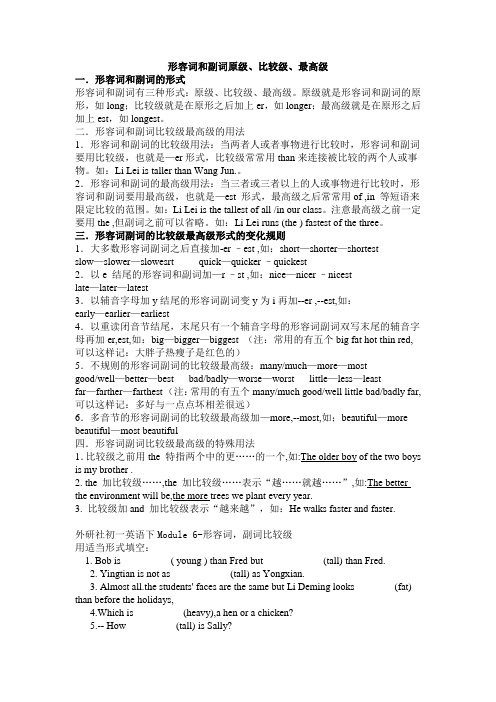
形容词和副词原级、比较级、最高级一.形容词和副词的形式形容词和副词有三种形式:原级、比较级、最高级。
原级就是形容词和副词的原形,如long;比较级就是在原形之后加上er,如longer;最高级就是在原形之后加上est,如longest。
二.形容词和副词比较级最高级的用法1.形容词和副词的比较级用法:当两者人或者事物进行比较时,形容词和副词要用比较级,也就是—er形式,比较级常常用than来连接被比较的两个人或事物。
如:Li Lei is taller than Wang Jun.。
2.形容词和副词的最高级用法:当三者或三者以上的人或事物进行比较时,形容词和副词要用最高级,也就是—est 形式,最高级之后常常用of ,in 等短语来限定比较的范围。
如:Li Lei is the tallest of all /in our class。
注意最高级之前一定要用the ,但副词之前可以省略。
如:Li Lei runs (the ) fastest of the three。
三.形容词副词的比较级最高级形式的变化规则1.大多数形容词副词之后直接加-er –est ,如:short—shorter—shortest slow—slower—slowesrt quick—quicker –quickest2.以e 结尾的形容词和副词加—r –st ,如:nice—nicer –nicest late—later—latest3.以辅音字母加y结尾的形容词副词变y为i再加--er ,--est,如:early—earlier—earliest4.以重读闭音节结尾,末尾只有一个辅音字母的形容词副词双写末尾的辅音字母再加er,est,如:big—bigger—biggest (注:常用的有五个big fat hot thin red,可以这样记:大胖子热瘦子是红色的)5.不规则的形容词副词的比较级最高级:many/much—more—mostgood/well—better—best bad/badly—worse—worst little—less—least far—farther—farthest (注:常用的有五个many/much good/well little bad/badly far,可以这样记:多好与一点点坏相差很远)6.多音节的形容词副词的比较级最高级加—more,--most,如;beautiful—more beautiful—most beautiful四.形容词副词比较级最高级的特殊用法1.比较级之前用the 特指两个中的更……的一个,如:The older boy of the two boys is my brother .2. the 加比较级……,the 加比较级……表示“越……就越……”,如:The better the environment will be,the more trees we plant every year.3. 比较级加and 加比较级表示“越来越”,如:He walks faster and faster.外研社初一英语下Module 6-形容词,副词比较级用适当形式填空:1. Bob is _________ ( young ) than Fred but ___________ (tall) than Fred.2. Yingtian is not as ___________ (tall) as Yongxian.3. Almost all.the students' faces are the same but Li Deming looks _______ (fat) than before the holidays,4.Which is _________ (heavy),a hen or a chicken?5.-- How _________ (tall) is Sally?-- She' s 1.55 metres ________ (tall). What abodt Xiaoling?-- She' s only 1.40 metres ________ (tall). She is much _______ (short) than Sally.She is also the _______ (short) girl in the class.6. He is ______ (bad) at learning maths. He is much _______ (bad) at Chinese and he is the _________ (bad) at English.7. Annie says Sally is the ________ (kind) person in the world.8.He is one of the_________(friendly) people in the class, I think.9. A dictionary is much _________ (expensive) than a story-book.10. An orange ia a little ______ (big) than an apple, but much ________ (small) than a watermelon.11. The Changjiang River is the _______ (long) river in China.12. Sue is a little ________ (beautiful) than her sister.13.My room is not as _________ (big) as my brother' s.14.--How difficult is physics?--I' m not sure.-- Is it ________ (difficult) than maths?-- I don' t think so.15.-- Annie plays the piano very ___________ (well).-- Sue plays it _____ (well) than Annie. And Sally plays it the ____ (well).16. Saturday is my _________ (busy) day in a week.17. Her mother is getting ____________(fat) and ________ (fat).18. I think it' s too expensive. I' d like a _____________ (cheap) one.19. He comes to school much ____________ (early) than I.20.This book is not as _____________ (interesting) as that one.21. Your classroom is __________(wide) and ___________(bright) than ours.22. Practise as __________ (much) as you can.23. The ________ (much), the ____________ (good).24. Nowadays English is __________( important ) than any other subject, 1 think.25. Most of the students think a lion is much ________(dangerous) than a bear and it is the __________ (dangerous) animal in the world.II改错:1. He is as taller as I am.2. She is a little thiner than she looks.3. Bob is heavier than any other boys in the class.4.The girls study the better than the boy.5. It is one of the most interesting book than I have ever read.6. He says Mary is most friendliest person in the class.7. Which city is most beautiful, Beijing or Guangzhou?8. Jack works hard. Mike works very harder than Jack.9. London is the bigger city in Britain.10.Bob plays football badly but Fred plays football much badlier than Bob.III完成句子:1 她看起来不如玛丽年轻。
形容词与副词

Exercise (as…as)
1 这棵树和那棵树一样高
This tree is as tall as that one.
2 他和他母亲起床一样早。
He gets up as early as his mother.
3 李萍不如王林学习努力。
Who studies harder, Mary or Tom?
3 比较级 +and+ 比较级
表示“越来越….”
The weather is colder and colder. She becomes more and more beautiful.
我们学习越来越努力。 We study harder and harder. 你越来越胖了。
Exercises 1. Tom is ________ boy in his class. D A. tall B. taller C. tallest D. the tallest
2.He is taller than his younger sister B A. more B. much C. very
1.China is the largest country in Asia. 2.The Summer Palace is one of the most beautiful parks in Beijing. 3.He studies hardest among us. 4.她是我们班最高的女孩。 She is the tallest girl in our class.
最高级 fastest worst largest biggest easiest most
形容词、副词的原级、比较级、最高级的用法

(1)单音节和部分双音节形容词和副词,在原级的后面加上er,est构成比较级和最高级。
a)直接加er,est :b)以重读闭音节结尾的,要双写最后一个辅音字母,后加er,est :c)以辅音字母+y结尾的,先把y改为i再加上er,est :(2)两个音节或两个以上的音节的,在原级前加more / most.(1)讲述某人/物自身的情况时,用原级。
基本句型是]主语+ 谓语动词+ (very/too/so/quite/) + 形/副词原级+….女口:He is very old now.(他现在很老了)They ran quite fast.(它们跑得相当快)The weather looks rather bad.(天气看上去相当糟)I am so happy!(我是如此的快乐)☆表示两者之间没有差别时, 使用句型:主语(第一个人物) + 谓语动词+ as + 形容词/副词原级+ as + 第二个人物+….如:He is as excited as his younger sister.(他和他妹妹一样兴奋)Lily rode her bike as slowly as an old lady.(莉莉骑车像老太太一样慢)They picked as many apples as the farmers (did).(他们摘的苹果和农民一样多)☆表示第一个人比不上第二个人时, 使用句型:主语(第一个人物) + 谓语动词(否定式) + as / so + 形容词/ 副词原级+ as + 第二个人物+….如:He is not so / as excited as his younger sister. (他没他妹妹那么兴奋)Lily did not ride her bike so / as slowly as an old lady.(莉莉骑车不像老太太那样慢)They didn 't pick so / as manyapples as the farmers (did).(他们摘的苹果不如农民多)(2)讲述两者有差异, 第一个人物超过第二个人物时, 用比较级。
中考英语--形容词、副词的原级、比较级用法总结

中考英语--形容词、副词的原级、比较级用法总结形容词/副词原级、比较级原级(表示人/物自身的情况时,或者同级比较时用原级)例如:The flower is very beautiful.这朵花跟漂亮。
Lily is as old as Cathy.Lily 和Cathy一样大。
原级的句型:主语+系动词(be动词)+as +形容词原级+as ...主语+实义动词+as +副词原级+as...(和...一样...)例如:Tom is as tall as Lily.Tom和Lily一样高。
Tom runs as quickly as Lily.Tom和Lily跑得一样快。
否定句.. not as/so + 形容词/副词原级+as... (前者不如后者... ) =... less + 形容词/副词原级+than ...例如:Tom isn’t as tall as Lily.Tom不如Lily高。
Tom doesn’t run as quickly as Lily.Tom不如Lily跑得快。
常见的修饰形容词/副词原级的程度副词:very, too, so, quite, enough等。
例如:The weather in Chongqing is very hot in summer.夏天,重庆的天气非常热。
比较级(用于两者之间的比较,用来表示“前者比后者更……”)例如:Tom is taller than his brother.Tom比他的弟弟更高。
Tom runs faster than his brother.Tom比他的弟弟跑得更快。
1. 形容词/副词的比较级变化:规则变化:(1)一般在词尾直接加er。
例如:tall-taller,long-longer(2)以不发音的字母e结尾的单词在词尾直接加r。
例如:nice-nicer,cute-cuter(3)以辅音字母+y结尾的词,把y变为i,再加er。
(完整版)初二形容词副词比较级、最高级
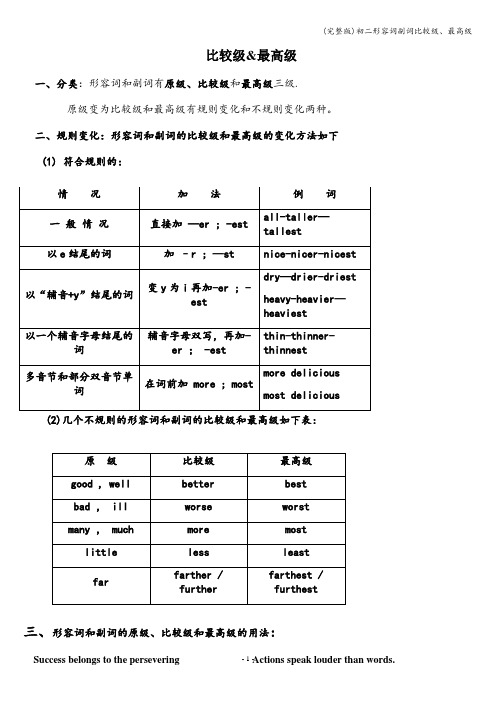
比较级&最高级一、分类:形容词和副词有原级、比较级和最高级三级.原级变为比较级和最高级有规则变化和不规则变化两种。
二、规则变化:形容词和副词的比较级和最高级的变化方法如下(1) 符合规则的:(2)几个不规则的形容词和副词的比较级和最高级如下表:三、形容词和副词的原级、比较级和最高级的用法:1e.g。
This room is bigger than that one. I am taller than you。
This lesson is more difficult than that one.注意:①修饰比较级的词有 a little, a bit ,a few , a lot ,much, even,still,far,rather,any 等表程度。
e。
g。
Today is _________ colder than yesterday(冷得多/一点)②为避免重复,在从句中常用the one 代替可数名词单数形式,调和ones 或those代替可数名词的复数形式,that代替不可数名词.E。
g。
The weather in Tianjin is colder than______of Guangzhou in winter.2、表示“…不如…”,用“less+原级+than”结构e。
g. The book is less difficult than that one. The film is less interesting than that one3、不与其他事物相比,表示本身程度的改变,用“比较级+and+比较级”结构,意思是“越来越…”e.g。
The weather is getting______ ______ 。
______ (越来越暖和)Our country is becoming _____ ______ . ______ (越来越漂亮)4、表示“两者之间比较。
形容词和副词原级的常用句型
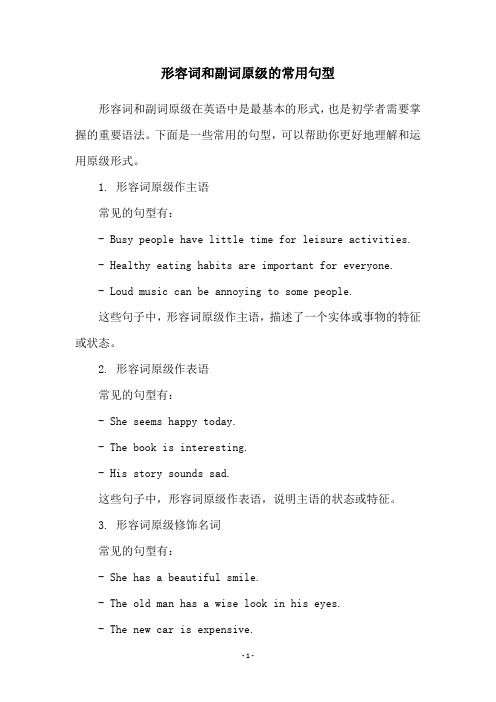
形容词和副词原级的常用句型形容词和副词原级在英语中是最基本的形式,也是初学者需要掌握的重要语法。
下面是一些常用的句型,可以帮助你更好地理解和运用原级形式。
1. 形容词原级作主语常见的句型有:- Busy people have little time for leisure activities. - Healthy eating habits are important for everyone.- Loud music can be annoying to some people.这些句子中,形容词原级作主语,描述了一个实体或事物的特征或状态。
2. 形容词原级作表语常见的句型有:- She seems happy today.- The book is interesting.- His story sounds sad.这些句子中,形容词原级作表语,说明主语的状态或特征。
3. 形容词原级修饰名词常见的句型有:- She has a beautiful smile.- The old man has a wise look in his eyes.- The new car is expensive.这些句子中,形容词原级修饰名词,说明名词的特征或状态。
4. 副词原级修饰动词常见的句型有:- She sings beautifully.- He speaks English fluently.- They work hard every day.这些句子中,副词原级修饰动词,说明动作的方式或程度。
5. 副词原级修饰形容词或副词常见的句型有:- She is very beautiful.- He runs extremely fast.- They are quite tired.这些句子中,副词原级修饰形容词或副词,说明其程度或强调其特征。
以上是形容词和副词原级的常用句型,希望对你学习英语有所帮助。
形容词和副词比较级和最高级的构成、用法及标志词

形容词和副词比较级和最高级的构成、用法及标志词我们知道形容词和副词有三个等级:1.原级,即原形。
2.比较级,表示“较……”或“更……一些”,两个事物进行比较。
3.最高级,表示“最……”,三个或三个以上的事物进行比较。
现在我们来看看它们的构成吧!第一,规则变化1. 现在词尾加-er/est.eg:tall-taller-tallestwarm-warmer-warmestquiet-quieter-quietest2. 以字母e结尾的词,在词尾加-r/-st.eg: late-later-latestfine-finer-finestlarge-larger-largestclose-closer-closest3. 以辅音字母加-y结尾的双音节词,先把“y”改为“i”,再加-er/-est.eg: easy-easier-easiestearly-earlier-earliestfunny-funnier-funniestfriendly-friendlier-friendliestbusy-busier-busiest4. 以只有一个辅音字母结尾的重读闭音节词,先双写辅音字母再加-er/-est.eg: big-bigger-biggesthot-hotter-hottestwet-wetter-wettestfat-fatter-fattestthin-thinner-thinnest5. 多音节词,在词尾加-more/-most.eg: beautiful-more beautiful-most beautifulserious-more serious-most seriousoutgoing-more outgoing-most outgoing第二,不规则变化不规则变化就只有这几个词,大家只需牢牢记在心里就好了。
good/well-better-bestbad/badly/ill-worse-worstmany/much-more-mostlittle-less-leastfar-farther/further-farthest/furthest以上是给同学总结的形容词即副词的比较级和最高级的构成,所举的例子也是常用到的单词,希望大家最好把这些单词背下来。
形容词副词的原级比较级

第9页/共26页
1、原级
意思
表示A和B一样
表示A不如B
二、用法
结构
A…as+原级+as B
A… not as/so+原级+as B
表示A是B的几 A… half, twice, three times…+as+
倍
原级+as B
第10页/共26页
3) I’m not ___A____ she / her.
A. as hard as B. as harder as
B
4) I don’t study _______ he / him.
C. as hard so
A. so careful as B. so carefully as C. more carefully as
5 其他双音节词(ly结 比较级在前 beautiful →more beautiful →
尾的副词)和多音节词,面加more,
most beautiful
最高级在前 difficult →more difficult →
面加most
most difficult
第3页/共ea26s页ily →more easily →most easily
quickly------ more quickly ----the most quickly
carefully---- more carefully ----the most carefully
heavily------ more heavily ----the most heavily
luckily------ more luckily ----the most luckily
形容词、副词的比较级和最高级

形容词、副词的原级、比较级和最高级一、形容词、副词的比较级和最高级的构成规则1.一般情况在原级词尾加-er,加-est ;如:small →smaller →smallest short →shorter →shortest tall →taller →tallestgreat →greater →greatest clever →cleverer →cleverest narrow →narrower →narrowest2.以不发音e 结尾的单音节词,比较在原级后加-r,最高级在原级后加-st ;如:large →larger →largest nice →nicer →nicest3.在重读闭音节(即:辅音+元音+辅音)中,先双写末尾的辅音字母,比较级加-er,最高级加-est ; 如:big →bigger →biggest hot →hotter →hottest fat →fatter →fattest red →redder →reddestwet →wetter →wettest thin →thinner →thinnest sad →sadder →saddest4.以“辅音字母+y ”结尾, 变y 为i,加-er,或加-est ;如:easy →easier →easiest heavy →heavier →heaviest busy →busier →busiesthappy →happier →happiest5.双音节词或多音节词,比较级在前面加more,最高级在前面加most ;如:beautiful →more beautiful →most beautiful different →more different →most different easily →more easily →most easily dangerous →more dangerous →most dangerous6二、形容词、副词的比较级的用法两者比较时用形容词和副词的比较级,表示两者之间的差异。
形容词和副词有三个比较等级
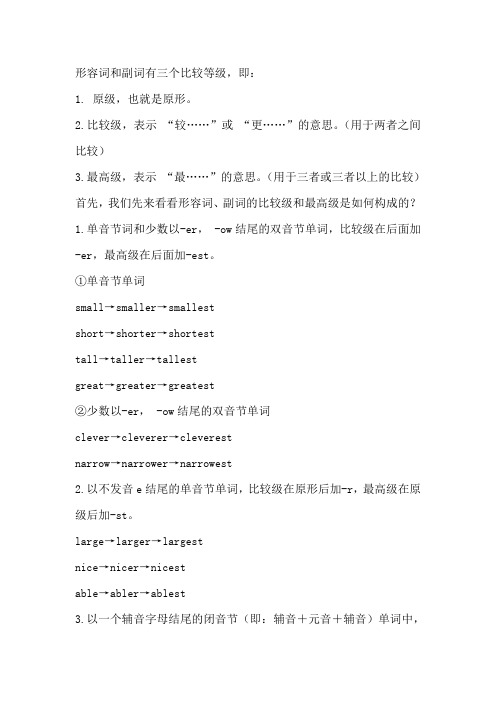
形容词和副词有三个比较等级,即:1. 原级,也就是原形。
2.比较级,表示“较……”或“更……”的意思。
(用于两者之间比较)3.最高级,表示“最……”的意思。
(用于三者或三者以上的比较)首先,我们先来看看形容词、副词的比较级和最高级是如何构成的?1.单音节词和少数以-er, -ow结尾的双音节单词,比较级在后面加-er,最高级在后面加-est。
①单音节单词small→smaller→smallestshort→shorter→shortesttall→taller→tallestgreat→greater→greatest②少数以-er, -ow结尾的双音节单词clever→cleverer→cleverestnarrow→narrower→narrowest2.以不发音e结尾的单音节单词,比较级在原形后加-r,最高级在原级后加-st。
large→larger→largestnice→nicer→nicestable→abler→ablest3.以一个辅音字母结尾的闭音节(即:辅音+元音+辅音)单词中,先双写末尾的辅音字母,比较级加-er,最高级加-est。
big→bigger→biggesthot→hotter→hottestfat→fatter→fattest4.以“辅音字母+y”结尾的双音节词,把y改为i,比较级加-er,最高级加-est。
easy→easier→easiestheavy→heavier→heaviestbusy→busier→busiesthappy→happier→happiest5.其他双音节词和多音节词,比较级在前面加more,最高级在前面加most。
beautiful→more beautiful→most beautifuldifferent→more different→most differenteasily→more easily→most easily6.有少数形容词、副词的比较级和最高级是不规则的,必须熟记。
形容词和副词的级别比较

形容词和副词的级别比较在英语中,形容词和副词都有不同的级别,用于比较事物的特征或行为的方式。
了解并正确使用这些级别是英语写作和口语表达的重要一环。
本文将介绍形容词和副词的三个级别:原级、比较级和最高级。
我们将探讨它们的用法和比较,以帮助你更好地理解和运用这些级别。
一、原级(Positive Degree)原级是形容词和副词的最基本形式,用于形容或修饰一个人、事物或行为。
它没有任何比较的概念,仅仅是描述某个事物的特征或行为的方式。
例如:1. 形容词的原级:- The house is big.(这所房子很大。
)- She is kind.(她很善良。
)2. 副词的原级:- He sings beautifully.(他唱得很美。
)- They walk slowly.(他们走得很慢。
)二、比较级(Comparative Degree)比较级是形容词和副词用于比较两个或多个人、事物或行为的级别。
在构成比较级时,形容词通常在词尾加上"-er",或在词前加上"more",而副词则在词尾加上"-er",或在词前加上"more"。
例如:1. 形容词的比较级:- The house is bigger than the one next door.(这所房子比隔壁那个房子大。
)- She is kinder than her sister.(她比她妹妹更友善。
)2. 副词的比较级:- He sings more beautifully than his friend.(他唱得比他朋友更美。
) - They walk more slowly than us.(他们比我们走得更慢。
)需要注意的是,有些形容词和副词的比较级是不规则的,需要记住它们的特殊形式。
例如:"good"(好)的比较级是"better"(更好),"bad"(不好)的比较级是"worse"(更差)。
形容词副词的比较级
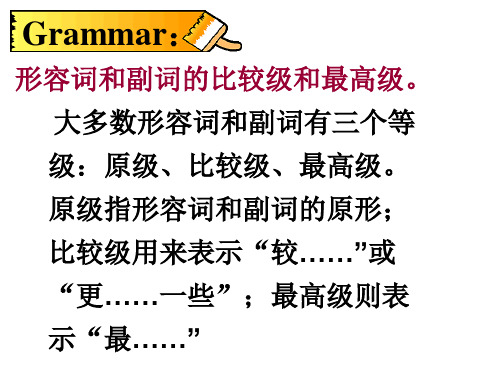
四、 比较级与最高级的互换 1.Jim is taller than any other boy in our class.(吉姆比我们 班上任何一个男孩都高)
= Jim is taller than the other boys in our class.(在我们班上吉姆其它的男孩高)
= Jim is the tallest in our class.(吉姆是 我们班最高的) 2. Jim is taller than any girl in our class. (吉姆比我们班的 任何一个女孩都高)
句型转换: 1. Tom is tall. Jim is short.(比较级合并) taller ______ than Jim. Tom is _______ 2. My hair is long. Mary’s hair is longer .(合并成一句) longer _______ than mine. Mary’s hair _______ _________ is 3. Pedro is thinner than Sam. (改为同义句) Sam is _______________ fatter/heavier ________ than Pedro. 4. My sister is better at study than me. She is clever. (改为同义句) more My sister is ___________ clever (聪明的) than me at study. 5. Peter is funny. Paul is funny, too. (合并成一句) as funny ________ as Peter is _______ Paul.
(6)The + 比较级…,the + 比较级… ―越…,就越…‖ eg:越多越好。 The more , the better. 你吃的越多,你就越胖。 The more you eat, the fatter you will become. (7)用形容词的比较级来表达最高级的概念: A+谓语+比较级+than any (other) +可数名词单数+范围。 “A是……中最……的”或“A比(其他)任何…… 都……‖ 注:当A在范围内比较时,必须加other;当 A不在范围内比较时,去掉other. eg:上海比中国其他的任何一个城市都大 Shanghai is bigger than any other city in China. 上海比日本的任何一个城市都大 Shanghai is bigger than any city in Japan.
- 1、下载文档前请自行甄别文档内容的完整性,平台不提供额外的编辑、内容补充、找答案等附加服务。
- 2、"仅部分预览"的文档,不可在线预览部分如存在完整性等问题,可反馈申请退款(可完整预览的文档不适用该条件!)。
- 3、如文档侵犯您的权益,请联系客服反馈,我们会尽快为您处理(人工客服工作时间:9:00-18:30)。
形容词和副词的原级、比较级和最高级的用法总结(1)讲述某人/物自身的情况时,用原级。
基本句型是:主语(sb./sth) + 谓语动词+ (very/too/so/quite/rather…) + 形容词/副词原级+….如:He is very old now.(他现在很老了)They ran quite fast.(它们跑得相当快)The weather looks rather bad.(天气看上去相当糟)I am so happy!(我是如此的快乐)☆表示两者之间没有差别时,使用句型:主语(第一个人物) + 谓语动词+ as + 形容词/副词原级+ as + 第二个人物+….如:He is as excited as his younger sister.(他和他妹妹一样兴奋)Lily rode her bike as slowly as an old lady.(莉莉骑车像老太太一样慢)They picked as many apples as the farmers (did).(他们摘的苹果和农民一样多)☆表示第一个人比不上第二个人时,使用句型:主语(第一个人物) + 谓语动词(否定式) + as / so + 形容词/副词原级+ as + 第二个人物+….如:He is not so / as excited as his younger sister.(他没他妹妹那么兴奋)Lily did not ride her bike so / as slowly as an old lady. (莉莉骑车不像老太太那样慢)They didn’t pick so / as many apples as the farmers (did). (他们摘的苹果不如农民多)(2) 讲述两者有差异,第一个人物超过第二个人物时,用比较级。
基本句型:主语(…A‟)+谓语动词+(much/a little/even/still)+形容词/副词比较级+than+第二个人物(…B‟)+….如:A modern train is much faster than a car.(现代的火车比轿车快多了)This book didn’t cost me more than that one.(这本书花费我的钱不比那本多)讲述两者有差异,第一个人物不及第二个人物时,用比较级。
句型是:主语(…A‟) + 谓语动词+ less+ (多音节形/副)比较级+ than + 第二个人物(…B‟) +….如:I think English is less difficult than maths.(我认为英语不比数学难)Do you think it less important to learn a foreign language?(你认为学外语不那么重要吗?) (3)讲述某人/物是一群之中最突出的一个时,用最高级。
句型是:主语(sb./sth) + 谓语动词+(the) +形容词/副词最高级+in / of ….如:The Changjiang River is the longest in China.(长江是中国最长的河流)He jumped (the) highest of the three (boys).(三个男生中他跳得最高)回顾:原级的构成和用法l)构成:形容词,副词的原级形式是形容词2)用法:表示双方在程度,性质,特征等某方面相等时,用" as 十原级形容词或副词十as"的结构;表示双方不相等时,用" not so (as)十原级形容词或副词十as"的结构;3)表示一方是另一方的若干倍时,用"倍数十as十原级形容词或副词十as"的结构.e.g. Ms.Sun speaks English as fluently as you.This building looks not so (as) high as that one.This room is three times as large as that one.提到倍数用法,补充:表示倍数的比较级有如下几种句型:1) A is three(four,etc) times as big(high,long,wide,etc.) as B.如:Asia is four times as larger as Europe,亚洲是欧洲的四倍大.(亚洲比欧洲大三倍.)2) A is three(four,ete) times the size(height,length,width,ete) of B.如;The new building is four times the size( the height) of the old one.这座新楼是那座旧楼的四倍大(四倍高)。
(这座新楼比那座旧楼大三倍[高三倍]).3) A is three(four,etc.) times bigger ( higher,longer,wider,etc.) than B.如:Your school is three times bigger than ours,你们的学校比我们的学校大三倍.(你们的学校是我们学校的四倍大.)用times表示倍数,一般只限于表示包括基数在内三倍或三倍以上的数.表示两倍可以用twice或doublelittle/few和many/much的比较级和最高级以及用法1)little less least修饰不可数名词2)few fewer fewest修饰可数复数名词3)much more most修饰不可数名词4)many more most修饰可数复数名词If you want to be thinner and healthier, you‟d better eat less food and take more exercise.(4)a bit, a little, not a bit, not a little的用法1)the +比较级+主谓,the+比较级+主谓:越。
越。
The harder he works, the happier he feels.2)比较级+and+比较级:越来越。
The weather is getting colder and colder.(5) elder的用法1)不能单独用作表语,因为elder不是真正意义上的比较级My sister is older( than me). My sister is elder(than me)2) 描述家庭人员出生的先后She is the older of the two.他是姐妹中较大的一个。
(6) 注意以下表达式的含义:the same…as(和……一样),no less than(不少于),not less than(只有),had better(最好),less than(不到),more or less(或多或少),other than(除了),rather than(而不是),the more…the more/less(越……就越……)6. 比较级和最高级的构成1)加-er,-est构成比较级和最高级。
单音节形容词和副词以不发音的-e结尾的high higher highest safe safer safesthard harder hardest late later latestsmall----smaller----smallest large----larger----largestnew----newer----newest nice----nicer----nicest辅音字母要双写的情况以辅音加-y结尾的情况big bigger biggest dry drier driesthot hotter hottest merry merrier merriestthin thinner thinnest easy easier easiest2) 加more, most构成比较级和最高级多音节的形容词expensive more expensive most expensive由形容词加-ly构成的副词slowly more slowly most slowlycarefully more carefully most carefullyhighly more highly most highly以-ful, -less, -able ,-ous, -ive, -ing等结尾的双元音形容词useless more useless most uselessserious more serious most serious分词形容词tired, pleased及glad, often, real, right, wrong等单音节形容词。
tired more tired most tiredglad more glad most glad形容词和副词最高级的用法,most/mostly/almost/at most 的含义7.形容词和副词最高级的用法三者或三者以上的比较用最高级。
表示最高程度时,用“the+最高级”的结构表示。
最高级中表示比较范围的常用among, in, of 引导的介词短语或从句表示。
Yesterday was the hottest day of the year.She is one of the most beautiful girls in our school.He works (the) hardest in his class.8. 用于修饰最高级的词最高级可以被序数词以及much, by far, nearly,,not quite,not really,nothing like等词语所修饰. 例如:This hat is by far/much/nearly/almost/not nearly/by no means/not quite/nothing like the biggest.How much did the second most expensive hat coat?The Yellow River is the second longest in China.9. 由 ing分词和 ed分词演变过来的形容词(包括不规则动词如know→ known)只能加more或most来表示它们的比较级和最高级more(most) interesting, more excited等。
10表示"最高程度"的形容词,如excellent,extreme,perfect等,没有最高级,也不能用比较级.1). most, mostly, almost, at most的用法。
